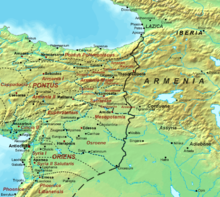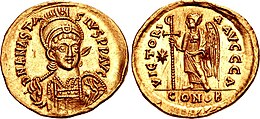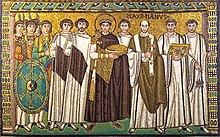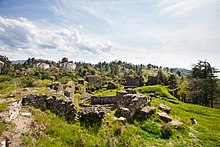Byzantine-Sasanian Wars
| Byzantine-Sasanian Wars | |||||||||
|---|---|---|---|---|---|---|---|---|---|
| Part of Roman-Persian Wars | |||||||||
 Illustration of the Battle of Nineveh (627), which became decisive in the history of the Byzantine-Sasanian wars | |||||||||
| |||||||||
| Belligerents | |||||||||
| List of allies | List of allies | ||||||||
| Commanders and leaders | |||||||||
Byzantine-Sasanian Wars or Byzantine-Persian Wars it is a series of conflicts between the Byzantine Empire and the Sassanian Empire that lasted 207 years and ended with the victory of Byzantine empire, after which the Sassanian Empire declined and was conquered by the Arabs after 30 years.
Background
[edit]
Throughout its history, the Sasanian Empire sought to gain control of the Middle East, justifying this with the Achaemenid legacy. Byzantine empire, in turn, sought to seize Transcaucasia and the trade routes coming from distant China.[1]
During Julian's Persian campaign, the Romans suffered a crushing defeat. As a result of the humiliating peace treaty for the Romans, a huge number of territories in the east were ceded to the Sasanian Empire, including Armenia.[2]
The last conflict in the history of the Roman-Sasanian wars was the Shapur 3 campaign in Armenia[3], as a result of the peace treaty, Armenia was divided into two parts: Persarmenia (territory ceded to the Sassanians) and Armenia Minor (territory ceded to the Romans).[4]
In 421, Bahram V became emperor of the Sasanian Empire and continued the persecution of Christians in the territory of the Sasanian Empire, which was started by his father Yazdigerd I.[5]
The Persians hired several Roman gold miners, but now refused to send them back; moreover, the Sassanids seized the property of Roman merchants. This was the reason for the first Byzantine-Sasanian war.
War of 421-422
[edit]The commander-in-chief of the Roman army was Ardabur, who, incidentally, came from the Iranian tribe of the Alans. Ardabur needed to collect many troops for his campaign. Theodosius, therefore, allowed some Pannonian Ostrogoths to settle in Thracia, to defend the province from the Huns while the Thracian Roman troops were sent to the East.
Ardabur sent Anatolius to Persarmenia, where he joined the rebels, while Ardabur entered Persian territory and devastated Arzanene. The general of the Sassanid army, Narses, engaged Ardabur in battle, but was defeated and forced to retreat. Narses planned to attack Mesopotamia, a Roman province that had been left unguarded, and moved there, but Ardabur foresaw his enemy's plan and intercepted him there.
Ardabur received reinforcements[6] and put the fortress of Nisibis under siege. Bahram allied with the Lakhmid Arabs of Alamundarus (Al-Mundhir I of Hirah), who, however, were dispersed by the Romans. In the meantime, the King of the Huns, Rua, had attacked the dioceses of Dacia and Thracia and had even menaced Constantinople; at the same time, a large Persian army moved towards Nisibis. To avoid a war on two fronts, Theodosius then recalled Ardabur.War of 440
[edit]
The Sasanian and the Roman Empire had since their peace treaty in 387 agreed that they both were obligated to cooperate in the defense of the Caucasus against nomadic attacks.[7] The Romans helped in the defense of the Caucasus by paying the Iranians roughly 500 lbs (226 kg) of gold at irregular intervals.[8] While the Romans saw this payment as political subsidies, the Iranians saw it as an opportunity to influence Roman military affairs.[9] The Roman emperor Theodosius II's unwillingness to continue the payment made shah Yazdegerd II declare war against the Romans,[9][7] which had ultimately little success for either side.[10]
The Romans were invaded in their southern provinces by the Vandals, causing Theodosius II to ask for peace and send his commander, Anatolius, personally to Yazdegerd II's camp.[11] In the ensuing negotiations in 440, both empires promised not to build any new fortifications in Mesopotamia and that the Sasanian Empire would get some payment in order to protect the Caucasus from incursions.[10]Anastasian War
[edit]
The Persian king Kavadh I was sorely short of money, for this reason he declared war on Byzantium. In 502, the Sassanid emperor invaded Byzantine empire, and captured a number of fortresses not ready for war by the Romans.[12]
Anastasius I sent an army of 52,000 men under the command of Areobindus[13]. This army was divided into two parts: one of them went to capture Amidah, the second besieged Nisibis[14]. Although the Byzantines were initially successful at Nisibis, they could not consolidate the advantage, Kavadh I forced Areobindus to retreat during a counterattack[15]. The second part of the army tried to come to the support of the first, but it was too late, the Persians defeated this army, separately from the army of Areobind.
Kavadh I, who reached Edessa, began demanding peace in exchange for a payment of 10,000 pounds from Byzantium, but Areobindus refused this.
The success of the Byzantine forces at Amida, as well as the invasion of the Huns, forced the Sassanids to retreat from Edessa[16].
Iberian War
[edit]

Lazica, a kingdom usually allied with the Persians, converted to Christianity and sided with Byzantium. He was followed by the rest of the Caucasian kingdoms, such as Iberia, to get out from under the influence of the Persians. The Persians tried to bring back the now Christian kingdom of Iberia to Zoroastrianism, but this kingdom rebelled, following its neighbor Lazica[17].
As part of his strategic consolidation of power in the East, Justinian I further strengthened the border defenses by incorporating the Armenian provinces into the empire and deploying Roman garrisons in the area.[18]
Already in 526, an open confrontation began between the empires in the Transcaucasus. At first, the Persians were lucky, the uprising in Iberia was suppressed, the Roman offensives were repelled, and attempts to strengthen the border were stopped by Persian raids.[19]
In 528, the Persians moved from Iberia to Lazica, where, in a small skirmish, they forced Belisarius to retreat to Dara.[20]
In 530, the Byzantines managed to win a number of major victories. Under Dara, Belisarius routed a completely superior force, while Sittas and Dorotheus defeated the Sasanian army at Satala (530). However, in 531 Belisarius was defeated at Callinicum and was removed from command of the army[21], the Persian general Azaret was also removed because he failed to take advantage of the victory at Callinicum.
After the failure of the Siege of Martyropolis and the death of Kavadh I, a peace was concluded, according to which Byzantium retained Lazica and the Sassanids retained Iberia.[22]
Lazic War
[edit]
Those calls were answered that year by the Persian king Khosrow I, who entered Lazica, captured the Byzantine main stronghold of Petra, and established another protectorate over the country.[23] Khosrow I retreated to Persia a year later after an abortive invasion of Commagene. In 543, a Roman invasion of Armenia was defeated by a small Persian force at Anglon, and Khosrow I unsuccessfully besieged Edessa in Mesopotamia a year later. A peace treaty was signed in 545.[24]



In Lazica, Khosrow I's attempt to establish direct Persian control over the country and the missionary zeal of the Zoroastrian priests soon caused discontent in Christian Lazica and King Gubazes revolted in 548, this time against the Persians. Gubazes II requested aid from Emperor Justinian I and allied with the Alans and Sabirs. Justinian sent 7,000 Roman and 1,000 Tzani (relatives of the Lazes) auxiliaries under Dagisthaeus to assist Gubazes and besieged the fortress of Petra but faced tough resistance from its heavily outnumbered garrison. Persian reinforcements under Mihr-Mihroe defeated a small Byzantine force guarding the mountain passes and then relieved the besieged Petra. Lacking enough supplies, Mihr-Mihroe garrisoned 3,000 men in the fortress and marched to Armenia leaving 5,000 soldiers to supply Petra. This force was destroyed by Dagisthaeus at the Phasis river in 549. The next Persian offensive also proved to be unsuccessful with the commander Chorianes killed in a decisive battle at the river Hippis (now the Tskhenistskali). Nevertheless, the Persians manage to resupply Petra. The new Byzantine commander Bessas quelled a pro-Persian revolt of the Abasgi tribe, took and dismantled the fort of Petra after a lengthy siege and fierce fighting as Mihr-Mihroe did not arrive in time. The latter unsuccessfully diverted his force against Archaeopolis in 551 as many of his men were lost due to a lack of supplies. However, the latter was unopposed elsewhere in the field and managed to capture Cotais and the fortress of Uthimereos, blocking the important roads to the highland regions of Scymnia and Souania, which were also captured by him later. In the summer of 555, he dislodged a superior Byzantine-Lazic force at Telephis and Ollaria by stratagem and forced them to retreat to Nesos. Mihr-Mihroe died of illness shortly after and was replaced by Nachoragan.
King Gubazes quarreled with Byzantine commanders Bessas, Martin, and Rusticus, complaining to emperor Justinian. Bessas was recalled, but Rusticus and his brother John eventually murdered Gubazes. To redress this with a victory on the battlefield, the Byzantine generals launched a full-scale assault at Onoguris, which was repulsed by a small force under Nachoragan, who momentarily took and destroyed the main Byzantine base at Archaeopolis, which Mihr-Mihroe had twice tried and failed to take. These defeats and the murder of the Lazic king caused a bitter feud between the Lazic and Byzantine generals. The Lazi people got the Emperor to nominate Tzathes, the younger brother of Gubazes, as their new king, and Senator Athanasius investigated the assassination. Rusticus and John were arrested, tried, and executed. In 556, the allies retook Archaeopolis and routed Nachoragan in his abortive attack on Phasis. In the autumn and winter of the same year, the Byzantines suppressed a rebellion staged by the mountain tribe of the Misimians, and finally made peace.War of 571-592
[edit]
Less than 10 years after the end of the Lazic War, tensions have risen again. The Persians invaded Yemen, expelling the Byzantine allies, and the allied Arabs raided the territories of Byzantium in the east.[25]
In 572, there was an uprising against the Persians in Armenia, which was suppressed, but the connection of the head of the uprising with the emperor helped unite all Christians in this region. This helped the Byzantines move deeper into Persia, all the way to Caucasian Albania.[26]
In Mesopotamia, however, the war began disastrously for the Byzantines. After a victory at Sargathon in 573, they laid siege to Nisibis and were apparently on the point of capturing this, the chief bulwark of the Persian frontier defences, when the abrupt dismissal of their general Marcian led to a disorderly retreat.[27]. Taking advantage of Byzantine confusion, Sassanid forces under Khosrow I swiftly counter-attacked and encircled Dara, capturing the city after a four-month siege. At the same time, a smaller Persian army under Adarmahan ravaged Syria, sacking Apamea and a number of other cities.[28]. They were only pushed away from Syria proper by a bumbling Byzantine defence near Antioch.[29] To make matters worse, in 572 the Byzantine emperor Justin II had ordered the assassination of the Ghassanid king al-Mundhir III; as a result of the unsuccessful attempt on his life, al-Mundhir severed his alliance with the Byzantines, leaving their desert frontier exposed[30].
In 575, the Byzantines managed to resolve their conflict with the Ghassanids[31], the latter in turn plundered the capital of the Arabs allied to the Persians.
Khosrow I prepared a grandiose campaign through the Caucasus to Anatolia, but during this campaign he was defeated near Melitene. The Byzantines took advantage of the situation and began raiding Caucasian Albania, wintering there and plundering territories. Khosrow wanted to ask for peace, but the victory of his general in Armenia stopped him.[32]
In 578, the main front moved to Mesopotamia. Mauritius has conducted successful raids on both banks of the Tigris. Khosrow wanted to ask for peace again, but died, and his heir Hormizd IV interrupted the negotiations.
In 582, Maurice became emperor, but in the 80s neither side was able to achieve anything. In 589, the Persian general Bahram 6, was able to repel the Roman offensive, but after a single defeat he was dismissed. The angry general raised an uprising, as a result of which Khosrow 2 was elevated to the throne, but Bahram was still dissatisfied, after a while Khosrow was forced to flee to Byzantium, and Bahram IV became emperor, but a year later he was defeated and Khosrow II came to power.
War of 602-628
[edit]
The Byzantine–Sasanian War of 602–628, also called the Last Great War of Antiquity,[h] was fought between the Byzantine Empire and the Persian Sasanian Empire. It was the final and most devastating conflict of the Roman–Persian Wars (54 BC – AD 628). The previous war between the two powers had ended in 591 after Emperor Maurice helped the Sasanian king Khosrow II regain his throne. In 602, Maurice was murdered by his political rival Phocas. Khosrow declared war, ostensibly to avenge the death of the deposed emperor Maurice. This became a decades-long conflict, the longest war in the series, and was fought throughout the Middle East, the Aegean Sea, and before the walls of Constantinople itself.
While the Persians proved largely successful during the first stage of the war from 602 to 622, conquering much of the Levant, Egypt, several islands in the Aegean Sea and parts of Anatolia, the ascendancy of the emperor Heraclius in 610 led, despite initial setbacks, to a status quo ante bellum. Heraclius's campaigns in Iranian lands from 622 to 626 forced the Persians onto the defensive, allowing his forces to regain momentum. Allied with the Avars and Slavs, the Persians made a final attempt to take Constantinople in 626, but were defeated there. In 627, allied with Turks, Heraclius invaded the heartland of Persia. After the Battle of Nineveh (627), Iranian forces were finally broken and Byzantium won war, forcing civil war-torn Persia to seek peace.
By the end of the war, both sides had exhausted their human and material resources. They were thus vulnerable to the emergence of the Islamic Rashidun Caliphate in the 630s, whose forces invaded both empires. Over the ourse of the rest of the seventh century, Muslim armies swiftly conquered the Levant, Mesopotamia, Persia, the Caucasus, Egypt, and North Africa. These conquests led to the fall of the Sasanian Empire and a significant reduction in the size and power of the Byzantine Empire, which over the following centuries would fight several wars with the Muslim powers for control of the Near East.List of Wars
[edit]| Date | War | Belligerents | Belligerents | Result | Note |
|---|---|---|---|---|---|
| (AD 440–628) | |||||
| 421–422 | Byzantine-Sasanian War of 421–422 | Byzantine Empire | Sasanian Empire | Byzantine victory[33] | Status quo ante bellum
|
| 440 | Byzantine–Sasanian War of 440 | Byzantine Empire | Sasanian Empire | Inconclusive | Status quo ante bellum
|
| 502–506 | Anastasian War | Byzantine Empire | Sasanian Empire | Inconclusive | Status quo ante bellum
|
| 526–532 | Iberian War | Byzantine Empire | Sasanian Empire | Inconclusive | Sasanians retained Iberia,Byzantines retained Lazica |
| 541–562 | Lazic War | Byzantine Empire | Sasanian Empire | Sasanian victory | Fifty-Year Peace Treaty |
| 572–591 | Byzantine–Sasanian War of 572–591 | Byzantine Empire | Sasanian Empire | Byzantine victory | Khosrow II restored to the Sasanian throne, Byzantine Empire get most of Sasanian Armenia and western half of Iberia |
| 602–628 | Byzantine–Sasanian War of 602–628 | Byzantine Empire | Sasanian Empire | Byzantine victory | Status quo ante bellum
|
See also
[edit]References and Notes
[edit]- ^ Dmitriev 2008, p. 4.
- ^ Gibbon 2008, p. 833.
- ^ Toumanoff 1961, p. 5.
- ^ Lang 1970, p. 163.
- ^ Greatrex 1991, p. 37.
- ^ Among which was a unit in which was enlisted an obscure soldier, Marcian, Emperor in 450, who, however, fell ill in Lycia and did not take part in the war (Theophanes, AM 5943).
- ^ a b Shayegan 2017, p. 809.
- ^ Payne 2015, pp. 296–298.
- ^ a b Payne 2015, p. 298.
- ^ a b Daryaee.
- ^ Frye 1983, p. 146.
- ^ Greatrex 1991, pp. 62–63.
- ^ Petersen, Leif Inge Ree (15 September 2013). Siege Warfare and Military Organization in the Successor States (400-800 AD): Byzantium, the West and Islam. BRILL. p. 342. ISBN 978-90-04-25446-6.
- ^ Shahid, Irfan (1995). Byzantium and the Arabs in the Sixth Century. Dumbarton Oaks. p. 21. ISBN 978-0-88402-214-5.
- ^ Heather, Peter J. (2018). Rome Resurgent: War and Empire in the Age of Justinian. Oxford University Press. p. 77. ISBN 978-0-19-936274-5.
- ^ Greatrex 1991, p. 69-71.
- ^ Borgeraze, A. (2012). "Revolt of Gourgen". Georgia (in Georgian). Vol. II. Tbilisi. pp. 211–212.
{{cite encyclopedia}}: CS1 maint: location missing publisher (link) - ^ Procopius, Wars, 1.17. 46–48.
- ^ Greatrex 1991, p. 85.
- ^ Conor Whately, Battles and Generals: Combat, Culture, and Didacticism in Procopius, 2006, Netherlands, p.238
- ^ Greatrex 1991, p. 93.
- ^ Greatrex 1991, p. 96.
- ^ Martindale, Jones & Morris 1992, pp. 559, 639; Bury 1958, pp. 101–102.
- ^ Bury, J. B. (2015). A History of the Later Roman Empire. Cambridge University Press. p. 34. ISBN 978-1-108-08317-1.
- ^ Greatrex 1991, pp. 135–138.
- ^ Greatrex 1991, p. 149.
- ^ Greatrex 1991, pp. 142–145.
- ^ Greatrex 1991, pp. 146–149, 150.
- ^ persianempire.info
- ^ & Greatrex 1991, p. 136.
- ^ Greatrex 1991, p. 153.
- ^ Greatrex 1991, pp. 153–160.
- ^ Decker 2022, p. 234.
- ^ Greatrex 1991, p. 226.
Notes
[edit]- ^ Most conflicts end in Byzantine victory, including the last decisive war, See: List of Greco-Persian wars
- ^ See: Arab conquest of Egypt, Muslim conquest of the Levant, Muslim conquest of the Maghreb
Bibliography
[edit]- Bury, John Bagnell (1958). History of the Later Roman Empire: From the Death of Theodosius I to the Death of Justinian, Volume 2. Mineola, New York: Dover Publications. ISBN 0-486-20399-9.
- Dmitriev, Vladimir (2008). Борьба Византийской империи и Сасанидского Ирана за господство в передней Азии [The struggle of the Byzantine Empire and Sasanian Iran for supremacy in the Near East] (in Russian). Pskov. ISBN 978-5-87854-429-0.
{{cite book}}: CS1 maint: location missing publisher (link) - Lang, David Marshall (1970). Armenia: Cradle of Civilization. George Allen & Unwin Ltd.
- Toumanoff, Cyril (1961). "Introduction to Christian Caucasian History: II: States and Dynasties of the Formative Period". Traditio. 17. Cambridge University Press: 1–106. doi:10.1017/S0362152900008473. JSTOR 27830424. S2CID 151524770.
- Greatrex, Geoffrey (1991). The Roman Eastern Frontier and the Persian wars.Part II.363-630AD. Routledge. ISBN 0-415-14687-9.
- Daryaee, Touraj. "Yazdegerd II". Encyclopaedia Iranica.
- Frye, R. N. (1983). "The political history of Iran under the Sasanians". In Yarshater, Ehsan (ed.). The Cambridge History of Iran, Volume 3(1): The Seleucid, Parthian and Sasanian Periods. Cambridge: Cambridge University Press. ISBN 0-521-20092-X.
- Martindale, John Robert; Jones, Arnold Hugh Martin; Morris, J., eds. (1992). The Prosopography of the Later Roman Empire, Volume III: A.D. 527–641. Cambridge, United Kingdom: Cambridge University Press. ISBN 978-0-521-20160-5.
- Payne, Richard (2015). "The Reinvention of Iran: The Sasanian Empire and the Huns". In Maas, Michael (ed.). The Cambridge Companion to the Age of Attila. Cambridge University Press. pp. 282–299. ISBN 978-1-107-63388-9.
- Shayegan, M. Rahim (2017). "Sasanian political ideology". In Potts, Daniel T. (ed.). The Oxford Handbook of Ancient Iran. Oxford University Press. pp. 1–1021. ISBN 9780190668662.
- Decker, Michael J. (2022). The Sasanian empire at War.Persia,Rome and the rise od Islam. Westholme Publishing,LLC. ISBN 978-1-59416-692-1.
- Gibbon, Edward (2008). The History of the Decline and Fall of the Roman Empire. ISBN 978-5-275-01704-5.


 French
French Deutsch
Deutsch